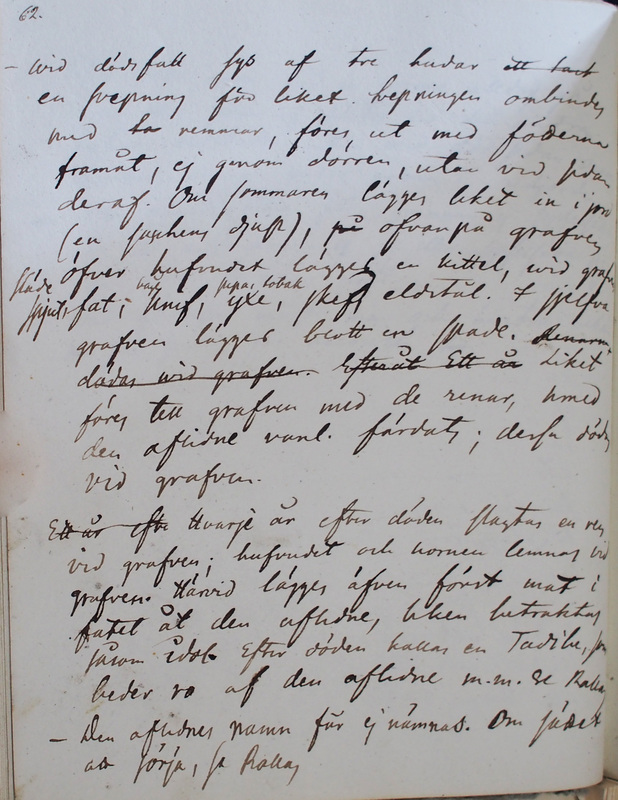Ethnographiska, historiska och statistiska anmärkningar. 062
Title
Description
|
Wid dödsfall
sys af tre hudar ett sackMost details come up in travelogues dating back to the 18th and 19th centuries. Chomič built an overall picture of the burial customs and death-related beliefs on the basis of sources from different places and times. (Chomič 1966: 217–222; see also Lepëchin 1805: 257; Islavin 1847: 135–139; Schrenk 1848: 522–528)
en svepning för liket. Svepningen ombindes med remnar, föres ut med fötterna framåt, ej genom dörren, utan vid sidan deraf. Om sommaren lägges leket in i jord (en saschens djup), ofvan på grafven öfver hufvudet lägges en kittel, wid grafven slädespjut, fat, båge, knif, yxe, pipa, tobak, skeft eldstål. I sjefva grafven lägges blott en spade. Renarne dödas wid grafven. Efteråt ett år Liket föres till grafven med de renar, h[var]med den aflidne vanl[igtvis]. färdats; dessa dödas wid grafven. |
In the event of death a winding-sheet is sewn for the corpse from three hides. The sheet is bound with straps and the deceased is carried out feet forward, not through the door, but at the side. In the summer, the corpse is laid into the soil (a saschen’s depth), a cauldron is placed on the grave over the deceased’s head, and by the grave a driving pole, saucer, knife, bow, axe, pipe, tobacco, and a fire steel. Only a shovel is laid in the grave. The deceased is carried to the grave by the reindeer that the deceased usually drove; these are killed by the grave. |
|
Ett år efter Hvarje år efter döden slagtas en ren
vid grafven; hufvudet och hornen lemnas vid grafven. Härvid lägges äfven först mat i fatet åt den aflidne, h[vil]ken betraktas såsom idol. Efter döden kallas en Tadibe,
somTN тадебя ʻshaman’. A Nenets shaman takes care of the interaction between the Nenets community with this world and the unseen world and its spirits. Before Castrén, Lepëchin, Zuev, Schrenk, and Veniamin described shamans and shamanic rituals. Later, Chomič (1981) and Lar (1998) aimed to describe the Nenets shamanism as a whole. Note that Castrén uses the interchangeable Ru kudesnik ʻmagician’, for тадебя. (Lepëchin 1805: 219–222, 264; Zuev 1947: 43, 46; Schrenk 1848: 394–407; Veniamin 1855: 119–120, 267)
beder ro af den aflidne m.m. Se Pallas
Pallas 1776: 74–76; 1788: 101.
|
Every year after the death, a reindeer is slaughtered at the grave; the head and antlers are left at the grave. Food is also put first in the dish of the deceased, who is considered as an idol. After the death, a Tadibe is called, who asks for peace from the deceased, etc. See Pallas. |
| Den aflidnes namn får ej nämnas. Om sättet att sörja, se Pallas
Pallas 1776: 74–76; 1788: 100–101.
|
The name of the deceased may not be mentioned. About the ways of mourning, see Pallas. |

